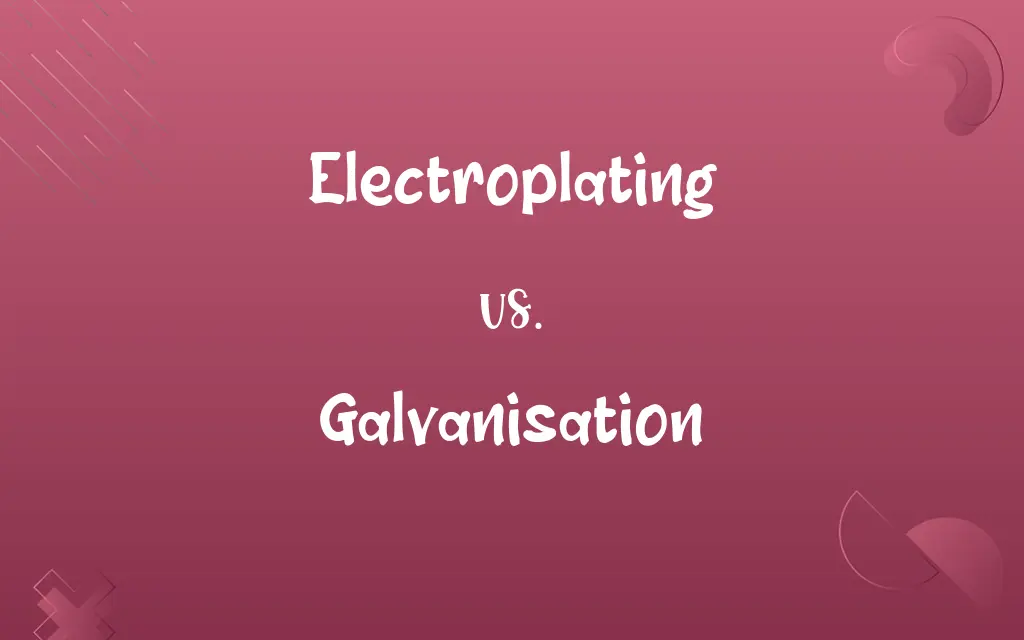Electroplating vs. Galvanisation: Know the Difference

By Shumaila Saeed || Updated on December 25, 2023
Electroplating involves coating an object with a metal using electrical current, while galvanisation is dipping steel into molten zinc for corrosion resistance.

Key Differences
Electroplating is a process where a metal layer is deposited onto a surface using an electric current. It's primarily used for enhancing appearance, corrosion resistance, or to reduce friction. Galvanisation, on the other hand, specifically involves coating iron or steel with zinc to prevent rusting. This process doesn't necessarily need electricity and usually involves dipping the metal into molten zinc.
Shumaila Saeed
Dec 17, 2023
The techniques used in electroplating require a direct current to reduce dissolved metal cations so they form a coherent metal coating on an electrode. This method allows for precise control over the thickness and composition of the plated layer. In contrast, galvanisation typically involves a simple dip in molten zinc, with less control over the coating's uniformity but a strong bond formed due to metallurgical reactions.
Shumaila Saeed
Dec 17, 2023
In terms of applications, electroplating is often used in industries like electronics, automotive, and jewelry, where specific characteristics such as conductivity or aesthetic appeal are important. Galvanisation is commonly used in construction and outdoor structures like fences and light poles, where the primary concern is longevity and protection against environmental elements.
Shumaila Saeed
Dec 17, 2023
The environmental impact of both processes also differs. Electroplating can involve a range of chemicals and requires careful waste management, while galvanisation is generally simpler and involves fewer hazardous chemicals. However, the high temperatures required for galvanisation can be energy-intensive.
Shumaila Saeed
Dec 17, 2023
Finally, the cost and complexity of electroplating can be higher due to the need for specialized equipment and precise control systems. Galvanisation, while still requiring significant industrial processes, is typically less complex and can be more cost-effective for large-scale projects.
Shumaila Saeed
Dec 17, 2023
ADVERTISEMENT
Comparison Chart
Process
Uses electrical current to deposit metal.
Involves dipping steel in molten zinc.
Shumaila Saeed
Dec 17, 2023
Application
Electronics, automotive, jewelry.
Construction, outdoor structures.
Shumaila Saeed
Dec 17, 2023
Control over Coating
High precision in thickness and composition.
Less control, but strong metallurgical bond.
Shumaila Saeed
Dec 17, 2023
Environmental Impact
Involves various chemicals, requires waste management.
Fewer chemicals, high energy for heating zinc.
Shumaila Saeed
Dec 17, 2023
Cost and Complexity
Higher due to specialized equipment.
Generally less complex and more cost-effective.
Shumaila Saeed
Dec 17, 2023
ADVERTISEMENT
Electroplating and Galvanisation Definitions
Electroplating
Electroplating is the process of applying a metal coating on an object using an electrical current.
The jewelry was electroplated with gold to enhance its appearance.
Shumaila Saeed
Dec 10, 2023
Galvanisation
Galvanisation is the process of applying a protective zinc coating to steel or iron.
The bridge was galvanized to protect it from corrosion.
Shumaila Saeed
Dec 10, 2023
Electroplating
It is a method to deposit a layer of one metal on another.
Electroplating copper onto iron creates a corrosion-resistant surface.
Shumaila Saeed
Dec 10, 2023
Galvanisation
Galvanisation is widely used in construction and outdoor applications.
The galvanised pipes are ideal for outdoor plumbing due to their resistance to weathering.
Shumaila Saeed
Dec 10, 2023
Electroplating
Electroplating enhances the aesthetic quality of objects.
Electroplating the vase with silver made it look more elegant.
Shumaila Saeed
Dec 10, 2023
ADVERTISEMENT
Galvanisation
Galvanisation is done to prevent rusting of iron or steel.
Galvanisation of the fence ensured it wouldn't rust easily.
Shumaila Saeed
Dec 10, 2023
Electroplating
Electroplating is used to increase corrosion resistance of metals.
They electroplated the car parts to prevent them from rusting.
Shumaila Saeed
Dec 10, 2023
Galvanisation
It involves dipping the metal in molten zinc.
The steel beams were sent for galvanisation to enhance their durability.
Shumaila Saeed
Dec 10, 2023
Electroplating
Electroplating can improve a material's wear resistance.
The gears were electroplated to extend their operational lifespan.
Shumaila Saeed
Dec 10, 2023
Galvanisation
It provides a rugged, protective layer to the metal.
Galvanisation of the metal sheets made them suitable for roofing.
Shumaila Saeed
Dec 10, 2023
Electroplating
To coat or cover with a thin layer of metal by electrodeposition.
Shumaila Saeed
Dec 10, 2023
Electroplating
A process of coating the surfaces of a metal object with a layer of a different metal through electrochemical means, usually to exploit different properties of the materials.
Shumaila Saeed
Dec 10, 2023
Galvanisation
Stimulation that arouses a person to lively action;
The unexpected news produced a kind of galvanization of the whole team
Shumaila Saeed
Dec 10, 2023
Electroplating
The art or process of depositing a coating (commonly) of silver, gold, or nickel on an inferior metal, by means of an electric current. The metal to be deposited on an article is usually used as the anode and the article to be plated as the cathode, in an electrolyte solution in which the plating metal is the cation. The process is conducted in a tank called an electroplating bath, which holds the electrolyte solution.
Shumaila Saeed
Dec 10, 2023
Galvanisation
Either the work of covering with metal by the use of a galvanic current or the coating of iron with zinc to protect it from rusting
Shumaila Saeed
Dec 10, 2023
Repeatedly Asked Queries
What is electroplating?
Electroplating is a process of coating an object with a thin layer of metal using an electrical current.
Shumaila Saeed
Dec 17, 2023
Why is galvanisation important?
Galvanisation is important for protecting steel and iron from corrosion, especially in outdoor applications.
Shumaila Saeed
Dec 17, 2023
Why is electroplating used?
Electroplating is used for enhancing appearance, corrosion resistance, and wear resistance of metals.
Shumaila Saeed
Dec 17, 2023
Is electroplating environmentally friendly?
Electroplating involves chemicals and requires proper waste management to be environmentally friendly.
Shumaila Saeed
Dec 17, 2023
What is galvanisation?
Galvanisation is the process of applying a zinc coating to steel or iron to prevent rusting.
Shumaila Saeed
Dec 17, 2023
What metals are commonly used in galvanisation?
Zinc is the most common metal used in galvanisation for its protective properties against rust.
Shumaila Saeed
Dec 17, 2023
How is electroplating thickness controlled?
Electroplating thickness is controlled by the duration of the electroplating process and the electrical current used.
Shumaila Saeed
Dec 17, 2023
How long does a galvanised coating last?
A galvanised coating can last several decades, depending on the environment and thickness of the coating.
Shumaila Saeed
Dec 17, 2023
What are the limitations of galvanisation?
Galvanisation can be less effective on complex shapes and joints, and the coating can be damaged by harsh impacts.
Shumaila Saeed
Dec 17, 2023
Can electroplating be done on any metal?
Electroplating can be done on most metals, but the process and chemicals used vary depending on the metal.
Shumaila Saeed
Dec 17, 2023
Can electroplating improve electrical conductivity?
Yes, electroplating with conductive metals like gold or silver can improve electrical conductivity.
Shumaila Saeed
Dec 17, 2023
Can electroplating be used for repair?
Electroplating can be used for repair, such as replenishing worn surfaces on tools or parts.
Shumaila Saeed
Dec 17, 2023
How does electroplating affect the appearance of an object?
Electroplating can significantly enhance the appearance, giving objects a shiny, polished look.
Shumaila Saeed
Dec 17, 2023
Can galvanised steel be recycled?
Yes, galvanised steel can be recycled without losing its protective properties.
Shumaila Saeed
Dec 17, 2023
What is hot-dip galvanisation?
Hot-dip galvanisation is a process where steel is submerged in molten zinc, forming a thick, rugged coating.
Shumaila Saeed
Dec 17, 2023
What safety measures are needed for electroplating?
Proper ventilation, chemical handling protocols, and protective gear are essential for safety in electroplating.
Shumaila Saeed
Dec 17, 2023
Does galvanisation affect metal strength?
Galvanisation typically doesn't affect the strength of the base metal significantly.
Shumaila Saeed
Dec 17, 2023
Can electroplated surfaces be painted?
Yes, electroplated surfaces can be painted, but surface preparation is necessary for proper adhesion.
Shumaila Saeed
Dec 17, 2023
How does the cost of galvanisation compare to other protective coatings?
Galvanisation is generally cost-effective compared to other protective coatings, especially for large-scale applications.
Shumaila Saeed
Dec 17, 2023
Is galvanisation suitable for all weather conditions?
Galvanisation is highly suitable for various weather conditions but can be less effective in highly corrosive environments like saltwater areas.
Shumaila Saeed
Dec 17, 2023
Share this page
Link for your blog / website
HTML
Link to share via messenger
About Author
Written by
Shumaila SaeedShumaila Saeed, an expert content creator with 6 years of experience, specializes in distilling complex topics into easily digestible comparisons, shining a light on the nuances that both inform and educate readers with clarity and accuracy.









































































